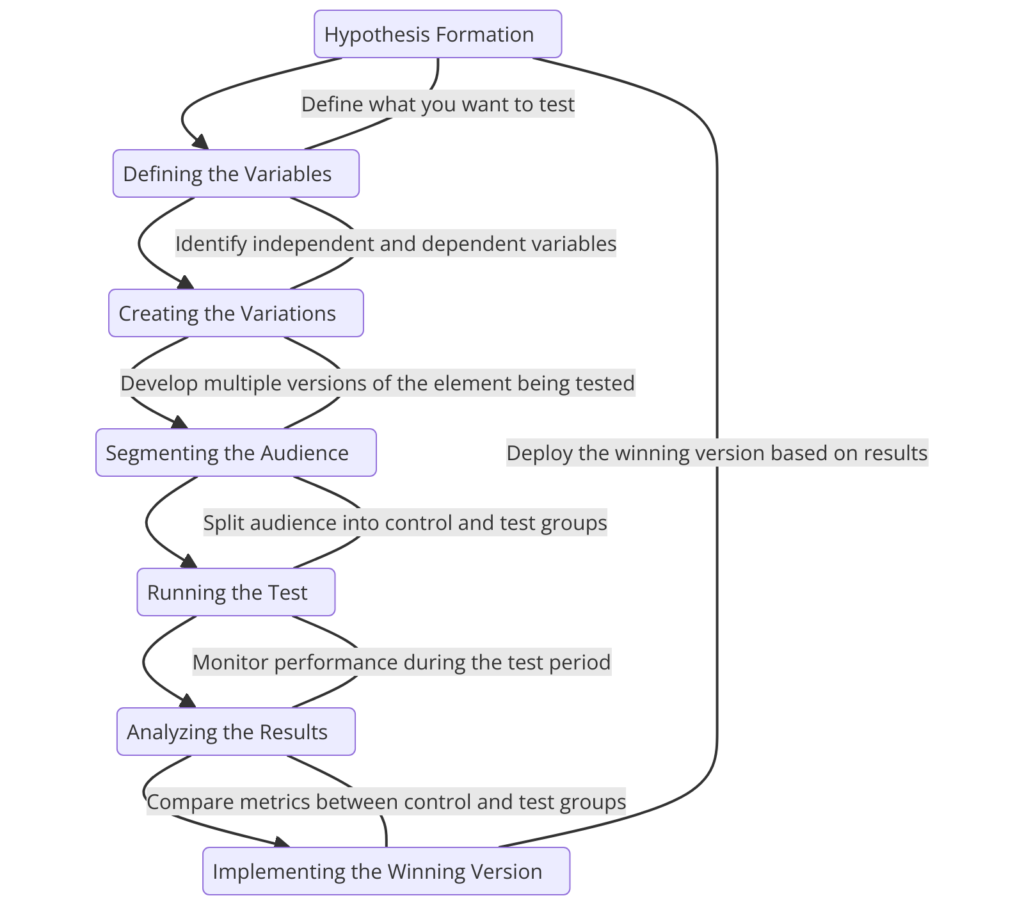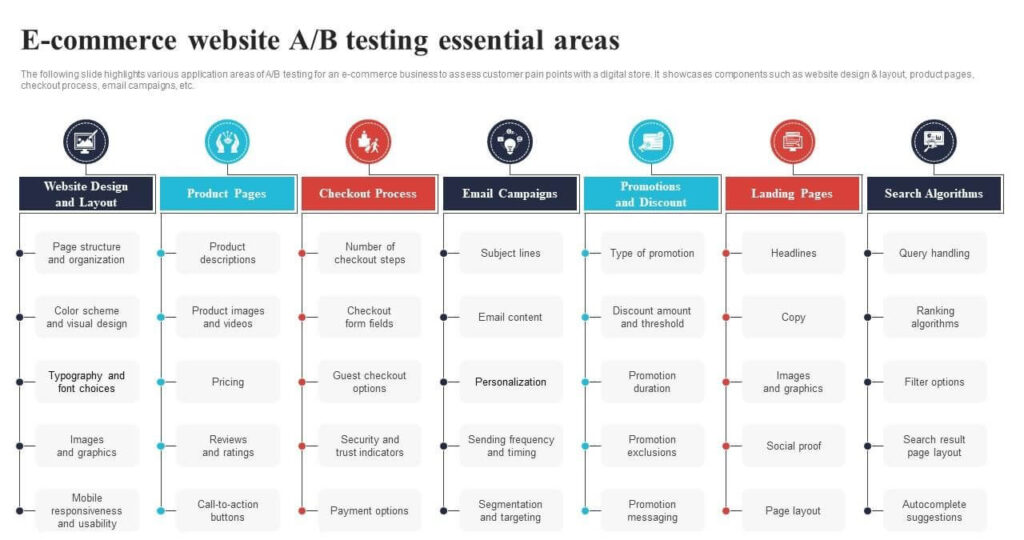In the fast-paced world of e-commerce, where consumer preferences shift rapidly and competition is fierce, the ability to make informed, data-driven decisions can be the difference between thriving and merely surviving.
A/B testing, a method that allows businesses to compare two versions of a webpage or marketing asset to determine which performs better, has emerged as a critical tool in optimizing user experiences and driving higher conversions.
This article delves into the essentials of A/B testing in e-commerce, exploring its methodologies, benefits, and best practices to help businesses increase conversions and achieve sustainable growth.
Understanding A/B Testing in E-commerce
A/B testing, also known as split testing, is a method of comparing two versions of a webpage or other user experience to see which one performs better. In the context of e-commerce, A/B testing is primarily used to optimize landing pages, product pages, and other elements of a website that directly influence conversion rates.
The concept is simple: a business creates two versions of a webpage (Version A and Version B) with a single variation between them—this could be anything from the headline, call-to-action (CTA) buttons, images, or layout. These versions are then shown to different segments of the website’s visitors, and their behavior is tracked and analyzed to determine which version yields better results, such as higher click-through rates, increased sales, or more sign-ups.
The Importance of A/B Testing in E-commerce
A/B testing plays a vital role in e-commerce for several reasons:
1. Data-Driven Decision Making
A/B testing empowers businesses to make decisions based on actual user behavior rather than assumptions or gut feelings. This leads to more effective strategies that are grounded in real data.
2. Improving User Experience
By testing different elements of a webpage, businesses can identify what resonates best with their target audience, leading to a more engaging and satisfying user experience.
3. Boosting Conversion Rates
Small changes, such as tweaking a headline or CTA button, can lead to significant improvements in conversion rates. A/B testing helps identify these high-impact changes.
4. Reducing Bounce Rates
By optimizing key elements of a webpage, A/B testing can help reduce bounce rates, ensuring that more visitors stay on the site and move further down the sales funnel.
5. Maximizing ROI
In a competitive market, the ability to optimize marketing spend and get the most out of each visitor is crucial. A/B testing helps ensure that every dollar spent on marketing contributes to measurable improvements in performance.
Key Components of A/B Testing in E-commerce
To effectively conduct A/B testing, it’s important to understand its key components and how they work together:

1. Hypothesis Formation
Before running an A/B test, it’s essential to start with a clear hypothesis. This hypothesis should be based on existing data, such as user feedback, analytics, or industry benchmarks. For example, a hypothesis might be, “Changing the color of the CTA button from blue to red will increase click-through rates by 10%.”
2. Defining the Variables
The next step is to define the variables—what will be changed and what will remain constant. In a typical A/B test, one element of the webpage (the independent variable) is changed while all other elements remain the same.
3. Creating the Variations
Once the variables are defined, create the two versions of the webpage: Version A (the control) and Version B (the variation). It’s crucial that only one element is changed between the two versions to isolate the impact of that change.
4. Segmenting the Audience
To ensure the test results are statistically valid, it’s important to randomly segment the audience into two groups, each of which will be shown one of the two versions. This ensures that the results are not skewed by external factors.
5. Running the Test
The test should run for a sufficient amount of time to gather enough data for analysis. The duration will depend on factors such as the amount of traffic the site receives and the significance level required.
6. Analyzing the Results
After the test concludes, analyze the results to determine which version performed better. This involves comparing metrics such as conversion rates, click-through rates, or sales between the two versions.
7. Implementing the Winning Version
If the test results indicate that Version B outperforms Version A, the next step is to implement the changes across the entire site. However, it’s important to continue monitoring performance to ensure the improvements are sustained over time.
Common Applications of A/B Testing in E-commerce
A/B testing can be applied to various aspects of an e-commerce website. Some of the most common applications include:

1. Testing Landing Pages
Landing pages are often the first point of contact between a business and potential customers. A/B testing can help optimize these pages to improve user engagement and increase conversions. Elements such as headlines, images, CTA buttons, and overall layout are often tested.
2. Optimizing Product Pages
Product pages are crucial in converting browsers into buyers. A/B testing can be used to test different product descriptions, images, pricing formats, and CTA buttons to see what drives the highest conversions.
3. Enhancing Checkout Processes
The checkout process is where many e-commerce businesses lose potential sales. A/B testing can identify friction points in the checkout process and test changes that may reduce cart abandonment rates.
4. Improving Email Campaigns
A/B testing is also widely used in email marketing. Businesses can test subject lines, email content, images, and CTA buttons to see what generates the highest open rates and click-through rates.

Image Source: Convertcart
5. Experimenting with Pricing Strategies
Pricing is a critical factor in e-commerce. A/B testing can be used to experiment with different pricing strategies, discount offers, or bundle deals to see what resonates most with the target audience.
Multivariate Testing vs. A/B Testing
While A/B testing focuses on testing one element at a time, multivariate testing allows businesses to test multiple elements simultaneously. For example, instead of just testing a CTA button, a multivariate test might test different combinations of headlines, images, and CTA buttons.
Advantages of Multivariate Testing
- Comprehensive Insights: Multivariate testing provides more detailed insights into how different elements of a webpage interact with each other.
- Faster Optimization: Since multiple elements are tested simultaneously, businesses can optimize their web pages faster.
Challenges of Multivariate Testing
- Complexity: Multivariate testing is more complex than A/B testing and requires more traffic to achieve statistically significant results.
- Higher Costs: The complexity and data requirements of multivariate testing often make it more expensive to implement.
Best Practices for Running an A/B Test in E-commerce
To maximize the effectiveness of A/B testing, it’s important to follow best practices:
1. Start with High-Impact Areas
Focus on testing elements that have the potential to significantly impact conversion rates. These are often high-traffic pages such as the homepage, product pages, or checkout pages.
2. Test One Element at a Time
To ensure the results are clear and actionable, it’s best to test one element at a time. This isolates the impact of each change and makes it easier to implement successful variations.
3. Use a Large Enough Sample Size
Ensure that your sample size is large enough to achieve statistical significance. This reduces the risk of making decisions based on random fluctuations rather than true user behavior.
4. Run the Test for an Appropriate Duration
It’s important to run the test long enough to gather sufficient data. Ending a test too early can lead to inaccurate conclusions.
5. Monitor External Factors
Be aware of external factors that could influence test results, such as seasonal trends, promotions, or changes in traffic sources.
6. Continuously Iterate
A/B testing is not a one-time effort. Continuously test and iterate on different elements to keep optimizing your e-commerce site for better performance.
The Benefits of A/B Testing in E-commerce
A/B testing offers a multitude of benefits for e-commerce businesses, including:
1. Higher Conversions
By identifying and implementing changes that resonate with users, A/B testing can lead to higher conversion rates, turning more visitors into paying customers.
2. Enhanced User Experience
A/B testing helps businesses understand what users prefer, leading to a more personalized and satisfying user experience. This, in turn, can result in higher customer satisfaction and loyalty.
3. Reduced Risk
A/B testing allows businesses to test changes on a small scale before rolling them out site-wide, reducing the risk of making costly mistakes.
4. Informed Decision Making
Rather than relying on intuition or guesswork, A/B testing provides concrete data that can guide decision-making. This leads to more effective strategies and better outcomes.
5. Improved Marketing ROI
By optimizing key elements of a website or marketing campaign, A/B testing helps businesses get the most out of their marketing spend, leading to a higher return on investment.
Challenges and Limitations of A/B Testing
While A/B testing offers significant benefits, it also has its challenges:
1. Time and Resources
Conducting A/B tests requires time and resources, particularly if multiple tests are run simultaneously. This can be a constraint for smaller businesses with limited bandwidth.
2. Potential for Inconclusive Results
In some cases, A/B tests may not yield clear winners, leading to inconclusive results. This can happen if the changes being tested are too subtle or if the sample size is too small.
3. Overemphasis on Short-Term Gains
There’s a risk that businesses may focus too much on short-term gains rather than long-term strategies. For example, a change that boosts conversions in the short term may not lead to sustainable growth over time.
Frequently Asked Questions (FAQs)
1. What is A/B testing in e-commerce?
A/B testing in e-commerce involves comparing two versions of a webpage or marketing asset to determine which one performs better in terms of user engagement and conversions. It helps businesses make data-driven decisions to optimize their websites and increase sales.
2. How does A/B testing help increase conversions?
A/B testing helps identify the most effective elements of a webpage, such as headlines, images, or CTA buttons, that resonate with the target audience. By implementing the changes that perform best, businesses can increase their conversion rates.
3. What is the difference between A/B testing and multivariate testing?
A/B testing compares two versions of a webpage with a single variation, while multivariate testing examines multiple elements simultaneously to see how different combinations affect user behavior. Multivariate testing provides more comprehensive insights but is more complex and requires more traffic.
4. How long should an A/B test run?
The duration of an A/B test depends on factors such as website traffic and the significance level required. However, it’s important to run the test long enough to gather sufficient data for analysis, typically several days to a few weeks.
5. What should I test first in an A/B test?
It’s best to start with high-impact areas that are likely to yield significant results, such as landing pages, product pages, or checkout processes. Focus on elements that directly influence user engagement and conversions.
Conclusion
A/B testing is an indispensable tool for e-commerce businesses seeking to optimize their websites and marketing campaigns. By making data-driven decisions and continuously iterating on what works best, businesses can improve user experiences, boost conversions, and ultimately achieve greater success in a competitive market. Whether testing landing pages, product descriptions, or email subject lines, the insights gained from A/B testing provide a clear path toward sustainable growth and increased profitability.
